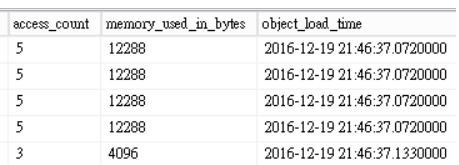針對非記憶體資料表,SQL2016提供了很多新的DMV來幫助我們分析和驗證Columnstore Index內部行為。
上一篇我提到sys.internal_partitions這新的DMV,這一篇我將介紹其他新增加的DMV。
基本名詞介紹
Columnstore:SQL2012推出第一個版本,所有資料將以欄位為單位進行儲存(非heap或B-tree),
這種索引結構有高度壓縮、低I/O和記憶體使用率優勢,對於data-warehouse查詢類型提供大幅效能改善。
Rowstore:傳統heap or B-tree索引結構。
Rowgroup:是指同時壓縮成資料行存放區格式的一組資料列,
資料列群組包含每一個欄位所定義的相同資料筆數.該群組資料數量取決為每一個欄位唯一性,
目前每一資料列群組資料上限為1048576。
Segment:索引中的資料列群組,有包含一個部分記錄資料單一壓縮欄位和和其他欄位合併的Segment(區段)資訊,
且每一個Segment都有相同的資料數量。
Dictionary:索引中的輔助結構,壓縮前置欄位至欄位區段,
且Dictionary和區段在物理上都會由儲存引擎轉換為獨立BLOB結構。
Deltastore:一種B-tree結構,用於儲存低於102,400的資料並壓縮至Columnstore,
一但Deltastore達到資料列群組最大筆數(1,048,576),便無法儲存更多資料,且狀態將從open變更為closed。
Delete Bitmap:一種B-tree結構,用於儲存Columnstore Index上被刪除的資料。
Tuple Mover:一條背景處理程序,用於檢查資料列群組為closed狀態,並壓縮資料進入Collumnstore。
sys.dm_db_column_store_row_group_operational_stats
傳回目前資料行存放區索引中的資料列層級 I/O、 鎖定和存取方法壓縮的資料列群組。
SELECT TOP 90 * FROM [dbo].StockItemTransactions
ORDER BY StockItemID ,TransactionTypeID
SELECT
OBJECT_NAME(csos.[object_id]) AS [Table]
, indx.[name] AS [Index]
, csos.[row_group_id]
, csos.[index_scan_count]
, csos.[scan_count]
, csos.[delete_buffer_scan_count]
, csos.[row_group_lock_count]
, csos.[row_group_lock_wait_count]
, csos.[row_group_lock_wait_in_ms]
FROM sys.dm_db_column_store_row_group_operational_stats AS csos
LEFT OUTER JOIN sys.indexes AS indx
ON indx.[index_id] = csos.[index_id]
AND indx.[object_id] = csos.[object_id]
ORDER BY [Table], [Index], csos.[row_group_id];
 Row_group_id=0,索引掃描3次。
Row_group_id=0,索引掃描3次。
用來判斷資料列群組所包含的資料數量和大小。當資料列群組中已刪除的資料列數增加到佔總列數的相當大比例時,
資料表的效率就會降低。 重建資料行存放區索引可縮小資料表,減少讀取資料表所需的磁碟 I/O。
一旦開啟的資料列群組已滿時,其狀態會變更為 Closed Closed 資料列群組會藉由 tuple mover(背景處理序)
壓縮為資料行存放區格式,並在狀態變更為壓縮。
SELECT
OBJECT_NAME(csrg.[object_id]) AS [Table],
indx.[name] AS [Index],
csrg.[row_group_id],
csrg.[delta_store_hobt_id],
csrg.[state_description],
csrg.[total_rows],
csrg.[deleted_rows],
csrg.[size_in_bytes]
FROM
sys.column_store_row_groups AS csrg
LEFT OUTER JOIN sys.indexes AS indx
ON csrg.[object_id] = indx.[object_id]
AND csrg.[index_id] =indx.[index_id]
ORDER BY [Table],[Index],csrg.[row_group_id];
 有四個資料列群組,狀態都是壓縮,依然可以接受更多資料,且沒有任何被刪除的資料。
有四個資料列群組,狀態都是壓縮,依然可以接受更多資料,且沒有任何被刪除的資料。
sys.dm_column_store_object_pool
傳回資料行存放區索引物件的記憶體集區。
SELECT
OBJECT_NAME(p.[object_id]) AS [Table],
indx.[name] AS [Index Name],
c.[name] AS [Column Name],
p.[column_id],
p.[row_group_id],
p.[object_type_desc],
p.[access_count],
p.[memory_used_in_bytes],
p.[object_load_time]
FROM sys.dm_column_store_object_pool p
LEFT OUTER JOIN sys.index_columns indxc
ON indxc.[index_column_id] = p.[column_id]
AND indxc.[index_id] = p.[index_id]
AND indxc.[object_id] = p.[object_id]
LEFT OUTER JOIN sys.columns c
ON indxc.[object_id] = c.[object_id]
AND indxc.[column_id] = c.[column_id]
LEFT OUTER JOIN sys.indexes indx
ON indx.[object_id] = p.[object_id]
AND indx.[index_id] = p.[index_id]
ORDER BY p.[memory_used_in_bytes] DESC;

 查詢記憶體使用量。
查詢記憶體使用量。
sys.dm_db_column_store_row_group_physical_stats
提供資料行存放區索引中所有的資料列群組相關資訊。
SELECT
OBJECT_NAME(indx.[object_id]) AS [Table],
indx.[name] AS [Index],
csps.[row_group_id],
csps.[delta_store_hobt_id],
csps.[state_desc],
csps.[total_rows],
csps.[deleted_rows],
csps.[size_in_bytes],
csps.[trim_reason_desc],
csps.[transition_to_compressed_state_desc],
csps.[has_vertipaq_optimization],
csps.[generation],
csps.[created_time],
csps.[closed_time],
100 * ( ISNULL ( csps.[deleted_rows], 0 ) ) / total_rows
AS 'Fragmentation'
FROM sys.indexes AS indx
INNER JOIN sys.dm_db_column_store_row_group_physical_stats AS csps
ON indx.[object_id] = csps.[object_id]
AND indx.index_id = csps.index_id
ORDER BY [Table],[Index],csps.[row_group_id];

 查看碎片程度並適時重建資料行存放區索引。
查看碎片程度並適時重建資料行存放區索引。
透過下面TSQL,留意索引碎片資訊
--查看資料表所有索引的I/O相關資訊
SELECT
OBJECT_NAME(os.[object_id]) AS [Table],
indx.[name] AS [Index],
indx.[type_desc] AS [Index Type],
ip.[internal_object_type_desc],
os.[range_scan_count],
os.[singleton_lookup_count],
os.[page_lock_count],
os.[page_io_latch_wait_count],
os.[page_io_latch_wait_in_ms],
os.[tree_page_io_latch_wait_count],
os.[tree_page_io_latch_wait_in_ms]
FROM
sys.dm_db_index_operational_stats (DB_ID(), NULL, NULL, NULL)
AS os
INNER JOIN sys.indexes AS indx
ON indx.[index_id] = os.[index_id]
AND indx.[object_id] = os.[object_id]
LEFT OUTER JOIN sys.internal_partitions AS ip
ON ip.[hobt_id] = os.[hobt_id]
AND ip.[index_id] = os.[index_id]
AND ip.[object_id] = os.[object_id]
AND ip.[partition_number] = os.[partition_number]
WHERE OBJECT_NAME(os.[object_id]) IN ('StockItemTransactions')
ORDER BY [Table], [Index], ip.[row_group_id];
GO
--查看資料表所有所以碎片資訊和資料行存放區索引有關delete_buffer狀態
SELECT
indx.[name] AS [Index],
indx.[type_desc] AS [Index Type],
ip.[internal_object_type_desc],
ip.[rows],
ps.[avg_fragmentation_in_percent],
ps.[columnstore_delete_buffer_state_desc]
FROM
sys.dm_db_index_physical_stats
(DB_ID(), NULL, NULL, NULL , 'LIMITED') AS ps
INNER JOIN
sys.indexes AS indx
ON indx.[index_id] = ps.[index_id]
AND indx.[object_id] = ps.[object_id]
LEFT OUTER JOIN sys.internal_partitions AS ip
ON
ip.[hobt_id] = ps.[hobt_id]
AND ip.[index_id] = ps.[index_id]
AND ip.[object_id] = ps.[object_id]
AND ip.[partition_number] = ps.[partition_number]
WHERE OBJECT_NAME(ps.[object_id]) IN ('StockItemTransactions')
ORDER BY OBJECT_NAME(ps.[object_id]), [Index];
Enjoy SQL Server 2016
參考
Concepts of SQL Server 2014 Columnstore
sys.column_store_row_groups (Transact-SQL)
sys.dm_column_store_object_pool (Transact-SQL)
sys.dm_db_column_store_row_group_operational_stats (TRANSACT-SQL)
sys.dm_db_column_store_row_group_physical_stats (TRANSACT-SQL)
Columnstore Indexes Versioned Feature Summary
SQL 2016: Columnstore row group Merge policy and index maintenance improvements
SQL Server Columnstore, B-Tree and Hybrid Index Performance Comparison for Data Warehouses
Exploring Columnstore Index Metadata, Segment Distribution and Elimination Behaviors
